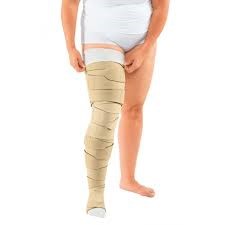Special 3 part blog series
Part 3 – What is the treatment for Lymphoedema?
Blog by Alyaa Mokh’ee (Lymphoedema Physiotherapist)
In this last part of the blog series, we will explore the treatment options offered by a certified therapists to manage your Lymphoedema.
The specific management of your Lymphoedema treatment will vary according to your goals, level of motivation for self-management, and the extent of your condition. Working alongside your Lymphedema therapist, you will collaborate to establish a personalised management plan which you will be required to integrate into your daily routine to optimise the on-going relief of your symptoms.
During the early stages of Lymphoedema, management is largely focused on education, exercises and elevation to assist with the self-management of your Lymphoedema. A compression garment/sleeve may also be prescribed for air travel and for exercises if deemed appropriate.
Education topics covered (not exhaustive):
- Lymphatic system and how they function
- Risk factors impacting lymphoedema
- Adopting a healthy lifestyle and encouraging exercises as tolerated
- Skin care to limit the exacerbation of lymphoedema
COMPLEX LYMPHOEDEMA THERAPY
Patients with lymphoedema that has progressed will likely require Complex Lymphoedema Therapy (CLT) to assist with lymphoedema management. This is usually done in 2 stages; the treatment phase before progressing to the self-management/maintenance phase. The primary aim of the treatment phase is to reduce as much of the swelling as possible. This phase can take up to a few days to a couple of weeks depending on the severity of the lymphoedema.
TREATMENT PHASE
Education
All patients will be offered an education session surrounding the lymphatic system and how it functions. The education session will also emphasise on the importance of healthy weight management and regular exercise.
Skin Care
Good skin care is paramount to the prevention of skin infections as they could aggravate your lymphoedema. Good skin involves ensuring that the skin is adequately moisturised and that you practise appropriate sun care in the warmer months. It is also recommended to regularly check for any skin breaks and/or monitor for any fungal infections that could increase your risk of infections.
Manual Lymphatic Drainage (MLD)
Manual lymphatic drainage is a specific massage that only a trained lymphoedema therapist can provide. It involves the strategic application of light pressure to stimulate specific lymph nodes to encourage lymph flow. Each MLD session will be tailored to the area and stage of swelling.
Self-Lymphatic Drainage (SLD)
Self-Lymphatic Drainage is usually a simplified version of the MLD, given to you to complete at home. It is recommended that you complete SLD to get the most benefit in between sessions with your lymphoedema therapist.
Compression Bandaging
Compression therapy via bandages is aimed at reducing the extent of swelling. It assists with improving lymphatic flow out of the affected area. Whilst compression is helpful to assist with the management/reduction of swelling, if implemented by an un-trained person, could lead to increased swelling in other areas of the body. Your lymphoedema therapist will discuss with you what is appropriate in your Complex Lymphoedema Therapy regime.



SELF-MANAGEMENT/MAINTENANCE PHASE
Once the swelling has reduced and is stable with minimal fluctuations, you will enter the self-management/maintenance phase. As the self-management/maintenance phase is lifelong, adherence is essential to ensure that the swelling does not return.
Education, skin care and SLD is encouraged in the maintenance phase as a tool for self-management.
Other options offered during the maintenance phase include:
Compression Garments

Compression garments may be prescribed to you to ensure maintenance of swelling reduction. Your lymphoedema

therapist will discuss with you what type and style of garment will suit your condition.
Wraps
Wraps can be prescribed as an alternative in instances where patients might not be able to tolerate or put on a compression garment. They aim to provide the same level of compression that compression garments do.


EMERGING TREATMENT OPTIONS
Pneumatic Pumps
This device provides pressure to the affected limb via a compression pump which mimics the principles of MLD and is usually used as an adjunct to SLD or MLD. It can be hired for home treatment or used in clinic (if available).

Low level Laser Therapy
At present time, there is some research suggesting that low level laser therapy could reduce any thickening of tissue, therefore improving lymphatic flow. This is usually used alongside lymphatic drainage and compression therapy. As it is an emerging therapy, with more research to be done, this option may not be available in all clinics.
While these treatments are offered by your lymphoedema therapist, there may be other surgical options that your doctor might suggest. In these cases, it is always best to consult with the appropriate specialist in order to determine what the best options is for your situation.
PART 1 – What is Lymphoedema?
PART 2 – How is Lymphoedema diagnosed?

